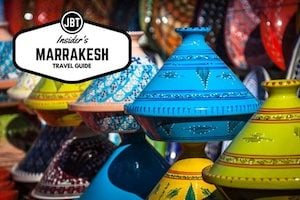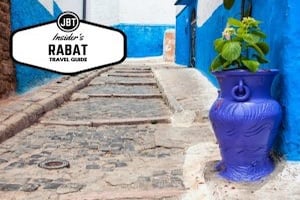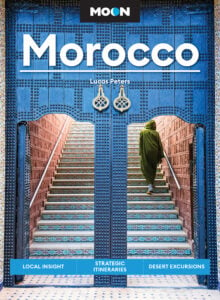
Alyson gave me a horrified look when I asked her how long the dada (a term often used to refer to female chefs at Moroccan hotels) had been teaching Moroccan cooking classes. “Don’t call her that! She’s a chef! I’ll explain later,” she whispered, glancing worriedly at Mona to make sure my question hadn’t been overheard.
Alyson, who is English, has been with cooking school L’Atelier Madada in Essaouira for over five years and provides translation and prep assistance to the students. More than that, she is an amazing encyclopedia of Moroccan culture and history. And Mona (pronounced “Moona”) is the undisputed queen of her domain, a chef with a pedigree: Her mother, now retired, was a chef at La Mamounia Palace Hotel in Marrakesh. Mona has been with the L’Atelier Madada since its inception in January, 2009.
This is about as professionally-run a cooking class as you’ll find anywhere in Morocco. The owner of the school, a Belgian man who goes by the name of Pacha, moved L’Atelier to its current location in January, 2017. The huge, modern kitchen can comfortably handle up to 8 people for a Moroccan cooking class at a time. Adjoining it is a café and boutique.
Like most cooking classes in Morocco, the menu is chosen by the first person to sign up. Ours was chicken tagine with caramelized carrots and tomatoes and 2 kinds of savory briouate, small samosa-like pastries: one with goat cheese and mint, the other with sautéed carrots, zucchini, and spices.
Each of us had our own station which was perfectly organized – a paper towel was even in place for wiping down our cutting boards after chopping onions. Mona showed us what she wanted done and Alyson added details as needed. As we worked, Mona came around inspecting, looking humorously exasperated at my ineptitude. My onions weren’t chopped fine enough, so she demanded “more chopping!” My briouatewas folded incorrectly. She unfolded it and had me do it again. Alyson jokingly offered to show us the whipping scars on her back. Mona’s exacting demands were tempered with a lot of laughing and warm smiles.

Everything was explained in great detail, including why they could not give us exact cooking times. Though this is frustrating to some people, the reality is that everyone’s kitchen is different and cooking time can vary tremendously from home to home. More important is how the food should look when it’s done. We started our chicken bone-side down. After about 30 minutes, we turned it to give the top a chance to brown a bit.
Alyson taught us how to shop for a tagine and how to use it. She told us to select the plate and top separately, even if they’re displayed as sets. If you don’t have a good seal, your tagine will take forever to cook; it’s like a clay pressure cooker when the parts fit well, sealing in moisture for tender meat. Make sure there are no holes that go through, for the same reason. Never soak it in water or it will either get moldy in storage or crack the next time you use it. And if you want to use a stewing pot instead of a tagine, it’s perfectly fine – just don’t call the dish “tagine.” Alyson claims that any good Moroccan cook can tell the difference.
When she was done explaining tagine ins-and-outs, we turned our chicken bone-side down again to finish cooking because if you leave it bone-side up, it will fall apart and look bad when it’s time to serve. If you take too long, it will lose heat and take much longer to cook. “Quick, quick!” Mona yelled.
While our tagines were in their final hour of cooking, Alyson took the group to visit a spice shop. As we walked, she explained her concern regarding the word “dada.” Although many riads use it when referring to their chefs, it’s actually a relic from Morocco’s slave-trading past: the dada was a female slave who served as nanny and cook for a family, and Mona wants nothing to do with that. Once, a drunken Moroccan man stumbled into her class, reached his arms out toward Mona and loudly exclaimed “DADAAA!” She reacted angrily to the offense while the class watched, stunned. It was not an experience Alyson wanted to repeat.
Mohammed, the owner of the spice shop, is one of a dying breed, a master who knows the medicinal purpose of every herb and spice he sells. With French-speaking Mohammed as backup, Alyson explained everything you would ever want to know about spices. Cumin is an amazing, fast-acting anti-microbial for your upset digestive system. Ras el Hanout, the famous Moroccan spice mixture, literally means “head of the shop,” and more generally, the “top spices of the shop.” It wasn’t originally intended merely as a culinary enhancement and Mohammed doesn’t sell Ras el Hanout out of a jar like other spice shops. In the old days if you were ill, a master like Mohammed would ask questions and diagnose your underlying health problem. Based on that, he’d assemble a “ras el hanout” intended just for you. You might make it into tea, or add it to your food, or even rub it on your body in the hammam, the traditional Moroccan bath.
When we returned to class, our tagines were ready, our briouates perfectly baked. We had labeled our dishes with our names so that we’d be sure to eat our own, for better or worse. We sat at a table in the café and relaxed while our creations were brought to us. The tagine lids were lifted, revealing steaming, aromatic deliciousness. I took a bite, savoring the best part of my tagine – the knowledge that I know how to make it again when I get home.
About the Author
 Since retiring in late 2016 from a career in IT, Mike Bernhardt has been visiting other cultures and writing about what he finds. When he’s not traveling he cooks international cuisine, plays his guitar, and on rainy days assists itinerant earthworms to cross the road.
Since retiring in late 2016 from a career in IT, Mike Bernhardt has been visiting other cultures and writing about what he finds. When he’s not traveling he cooks international cuisine, plays his guitar, and on rainy days assists itinerant earthworms to cross the road.
You can read about his adventures at travelingwithmikeandyvonne.com.







